Bronx Electeds, Residents Cry Foul as Mayor and Council Announce Jail Site
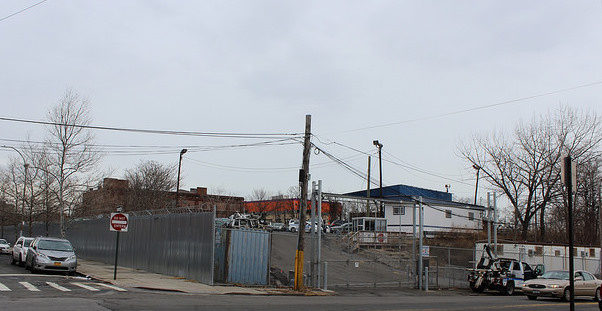
Planned Bronx jail site (photos: Samar Khurshid/Gotham Gazette)
When Mayor Bill de Blasio and City Council Speaker Corey Johnson announced last week that they’d reached a deal to speed up the closure of Rikers Island by creating or expanding jail facilities in every borough except Staten Island, it seemed to be a clear sign of a productive partnership between the administration and local elected officials.
The mayor and speaker made the announcement at a news conference at City Hall, alongside four Council members -- Diana Ayala, Karen Koslowitz, Stephen Levin, and Margaret Chin -- willing to accept the political risk of a new or expanded jail in their districts. The city will launch a unified land use review application for all four jails, the mayor and speaker said, combining the arduous and lengthy multi-stage approval process for siting certain municipal facilities.
But the proposal to build the Bronx jail -- the only one of the four that is not either a current or former jail facility -- immediately raised the hackles of elected officials from the borough other than Ayala, a newly elected Council member whose districts spans East Harlem and part of the South Bronx.
“Look the site in the Bronx is a site owned by the City of New York. It is a very smart site in terms of its closeness to the courthouses,” de Blasio explained at the news conference, when asked about a critical statement put out by Bronx Borough President Ruben Diaz Jr., who had not been kept in the loop by the administration or the Council. “There is going to be a full community process, but let's be clear, we're going to talk to everyone, we're going to listen to everyone, we're going to try in every way possible address community needs and address other benefits that communities need.”
De Blasio emphasized, “That being said, up here are the people who ultimately have to make the decision – the Council, represented by the Speaker, the members who represent those individual districts, and me and my administration.”
Ayala was aware of the criticism she may face for supporting a site in her district. “We all know that this siting process is bound to be controversial,” she said. “In the Bronx in particular, we are not repurposing an existing detention center but instead building a brand new facility that will require additional careful thought, serious consideration and robust community engagement, and I really wanna underline that…We also know that in the Bronx, too often we see a concentration of city facilities in our borough and there is rightfully some resistance to that. But we in the Bronx also understand the urgent need for criminal justice reform.”
Top Bronx officials were taken aback that this was the first they were hearing of a new jail intended for their backyard. Any consultations that had happened had excluded Borough President Diaz Jr.; Assemblymember Michael Blake, whose district neighbors the one where the proposed site is located at 320 Concord Avenue, currently an NYPD tow pound; and Assemblymember Marcos Crespo, the Democratic Bronx County party leader whose support helped Johnson win the speakership.
“I was surprised to learn that the administration has already selected a site for a new jail in The Bronx,” said Diaz Jr. in a statement that preceded the mayor and speaker’s Wednesday news conference. The proposed site had been first revealed by the Wall Street Journal the previous night, just after de Blasio delivered his State of the City address. “I hope that, going forward, this lack of outreach is not a harbinger of the amount of community input the people of my borough will have in this process,” Diaz Jr. said. (At the news conference, Johnson showed some contrition immediately, apologizing to Diaz Jr. and promising a “robust, meaningful” community engagement process.)
“It is simply disrespectful that a decision of this magnitude of proposing to open a new jail in the South Bronx was made behind closed doors, without engaging the broader Bronx community,” said Assemblymember Blake, in a statement released Wednesday night.
Crespo, the Democratic Bronx county boss, took to Twitter, calling out the mayor and speaker. “We spent so much time talking the last few months how did this rikers plan in my district never come up?” he wondered.
“I think we were all caught off guard with how far ahead the city seems to be when no one in the Bronx was informed of the process,” Crespo later elaborated, in a phone interview with Gotham Gazette. “Once you decide on a site, that’s gonna have an impact for generations.”
Crespo and the other electeds aren’t opposed to the administration’s goal: building capacity in the boroughs so that Rikers can close. But, he said the Concord Avenue site is not the best option, and the city should explore alternatives. The community and the borough already host their fair share of municipal facilities, Crespo insisted, echoing widespread criticism that the city has long chosen to place seemingly undesirable facilities such as jails, homeless shelters, and waste treatment plants in low-income communities of color. “Make no mistake about it, this borough has been handling an unfair share already for a long time,” he said.
“There’s major investments and their success would also be endangered,” he said of the Mott Haven neighborhood, where new development is underway literally across the road from where the jail would be situated.
The rapid outpouring of criticism didn’t seem lost on Speaker Johnson, who quickly seemed to equivocate on the Bronx site. “I am committed to facilities in the Bronx, Queens, Brooklyn and Manhattan,” Johnson told NY1. "We are not wedded to an individual location. If there is a better location I am happy to have that conversation."
Responding to an assertion that he was backpedaling, Johnson said in a subsequent tweet that he is “not at all” backing away from the site, but reiterated that the main goal is closing the jails on Rikers Island and that he is “not wedded” to one location. “If there's a better one,” he wrote, “I'm all ears. No other location has been presented.”
If the Bronx elected officials were stunned by the announcement, it’s little wonder that those who live in the neighborhood around the proposed site were likewise surprised and offended to learn of the plan.
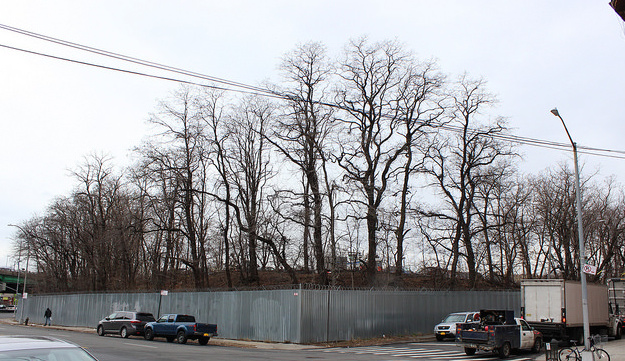 The site is located in the Mott Haven neighborhood of the Bronx, north of the Harlem River, with large industrial and manufacturing spaces running between the waterfront and the Major Deegan Expressway.
The site is located in the Mott Haven neighborhood of the Bronx, north of the Harlem River, with large industrial and manufacturing spaces running between the waterfront and the Major Deegan Expressway.
Residents and others expressed a mix of astonishment, resignation, anger, and resentment as Gotham Gazette told them on Friday that the city intended to build a jail within blocks of their homes and places of work.
“I thought they were gonna do a mall,” said Jesus Ortiz, 50, who runs an auto-repair shop across the street from the NYPD tow pound that occupies the block.
The site is sandwiched between East 141st and 142nd Streets, next to Bruckner Boulevard, in a neighborhood with a mix of housing and commercial properties. Enclosed by metal sheet walls, the tow pound is almost a hill overlooking its neighbors, with impounded cars visible from the street through a peripheral treeline that is leafless in February.
“They’re trying to rebuild the South Bronx to make it nice,” said Ortiz, “That’s not the way to rebuild, by putting a jail here.” Having worked there 15 years, Ortiz said he’s seen rapid development in recent times. Even the building that houses his auto shop was recently bought out, he said, and the landlords gave him a one-year lease till 2019. He’ll soon be gone from the neighborhood too.
“They’re buying all around,” he said.
Adam Bele, 40, loads containers at the lumber supply warehouse that sits behind 320 Concord. “Nobody wants to be near a jail,” he said. His biggest concern, one that others shared as well, is for the children that attend the several schools in the neighborhood.
“You don’t want children hanging around a jail,” said the father of two infants who will likely attend one of those schools, he said.
As with other residents, Bele was wary of the process for choosing the site. “It’s like they know it’s gonna be unpopular so they tried to hide it and do it quick, quick, quick,” he said. He had a simple piece of advice for the mayor. “Be transparent. Listen to this community, and take our recommendations into consideration.”
But Bele empathizes with the city’s rationale that detainees deserve to be housed closer to their families in humane and modern facilities, and that Rikers needs to close. “You don’t want them treated like animals, they’re human like us,” he said. The mayor and speaker have promised to seek community feedback on the proposed site and, as required by the city’s land use review process, community boards will get an opportunity to hold votes, albeit nonbinding, to approve or reject the proposal. Borough presidents also get to weigh in with advisory opinions.
Along Concord Avenue, in what could eventually be the shadow of a new jail, sit rowhouses, a few of them old and abandoned and showing signs of disrepair. “For Sale” signs hung in a few windows.
In one of those houses lives Nereida Chavez, 38, a stay-at-home mom with four kids. “Oh my god!” she exclaimed on hearing that her biggest neighbor could one day be a jail.
“I don’t like the idea of having a jail here,” she said. “It’s just scary.”
She worried that a jail could mean more traffic along a little-traversed street. “We have our kids and they love to play out here with their bikes,” she said. And, it might also mean that parking, which has become an issue already owing to the large lumber and oil and gas companies around them, might worsen. “We hardly have any parking here. It’ll be even more complicated if they put a jail here,” she said.
But Chavez was more concerned that she hardly had an opportunity to be heard on an issue that quite directly would affect her. “It makes me worried that things happen around us and we don’t know anything,” she said. “They also put shelters around us. They don’t let us know until it’s there.”
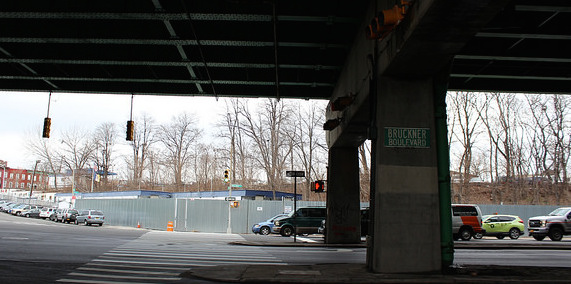 At a bodega on East 141st Street, Mel McKenzie, 33, was buying milk. Gotham Gazette asked if the homemaker knew about the city’s plan to build a jail, three blocks from her home.
At a bodega on East 141st Street, Mel McKenzie, 33, was buying milk. Gotham Gazette asked if the homemaker knew about the city’s plan to build a jail, three blocks from her home.
“For real?” she said.
“I’m not with it,” she frowned. “It should stay an impound lot....[A jail] won’t bring the community together. It’ll probably make us scared. And it’s too close to home.”
Another shopper, Nancy Lopez, 43, chimed in. “Why move it so close when there’s other areas where they could put it?” she wondered. “Put it across Bruckner where it’s more industrial. There’s kids that walk by everyday on Concord.”
The city’s plan to close Rikers and replace some of its capacity in borough facilities near courthouses entails building for about 6,000 inmates, with the goal of getting the jail population down to about 5,000, according to the mayor.
McKenzie acknowledged that its a laudable objective to help detainees, most of whom are pre-trial and not convicted of any crime, remain connected to their communities. “That makes sense,” she said, but she also expressed concern about what school-going children would take away from it. “That’s the message they’re sending? You’re gonna be close to home if you get locked up.”
“What happens if a prisoner escapes?” said Lopez, who said she is on disability and lives on Concord Avenue in the same row as Nereida Chavez. Instead, she proposed a “positive” alternative. “Why don’t they build affordable housing?”
Both women had one shared concern, however, that neither of them had received an opportunity to weigh in. “They should notify the public,” McKenzie said.
“As it’s happening, not when it’s already decided,” added Lopez. The city will present plans to the public, particularly through the community board, when the site is set for its place in the land use review process. It may be up to local residents to seek out opportunities to hear more and provide their feedback.
Presenting the site as a “fait accompli” would undermine the process, said the Bronx borough president in his statement, but it’s what one resident seemed to expect from the administration. “The city does whatever it wants,” said Hector Camilo, 55. “It doesn’t matter. You can’t argue with the city.”
***
by Samar Khurshid, senior reporter, Gotham Gazette
@samarkhurshid @GothamGazette
Note - This article has been corrected to note that Assembly Member Michael Blake does not represent the district where the proposed jail site at 320 Concord Avenue is located. He represents a neighboring district.
Next Steps and Recent Precedents for De Blasio’s Charter Revision Commission
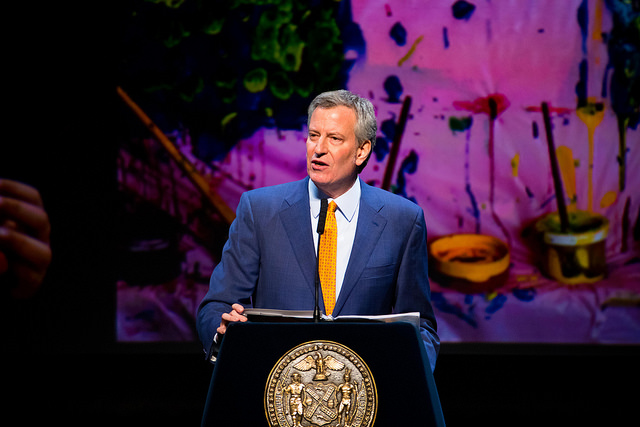
Mayor de Blasio (photo: Benjamin Kanter/Mayor's Office)
Last week, Mayor Bill de Blasio announced in his State of the City speech that he would convene a commission to consider changes to the city charter, New York City’s seminal governing document. De Blasio said the charter revision commission would undertake the significant task of reducing the impact of “big money” on local elections and to engage voters in a democracy that has suffered from their apathy. The mayor is hoping the commission members, whom he has yet to name, will prepare recommendations in time for voters to approve or reject the commission’s ideas on Election Day this November through one or more ballot questions.
De Blasio is ready to utilize a power available to him, though some are already questioning why he isn’t pursuing his desired changes through legislation at the City Council, while others are criticizing the mayor for pre-determining the panel’s outcomes. But, de Blasio will do as several predecessors have done and call a commission. How exactly does it work?
The mayor has the power to call a Charter Revision Commission under Section 36 of the state’s municipal home rule law. A commission can be composed of between 9 and 15 members, who would all have to be residents of the city. The mayor simply has to file the names of his chosen members, who can include current public officials, with the City Clerk’s office. There is no public vetting process, but de Blasio has conceded that he is open to input from concerned elected officials about who should serve on the body.
“I’m going to act in the manner stipulated in the City Charter,” the mayor said at an unrelated news conference on Feb 14, when asked by Gotham Gazette if he’d let other elected officials choose members for the commission, as some were calling for even before de Blasio’s announcement. “So, I’ll be naming the commission. I’m happy to talk to my colleagues in government about people they think would be right to serve, but I will name the commission just as previous mayors did.”
De Blasio said in his State of the City speech that he would “give [the Commission] the mandate to propose a plan for deep public financing of local elections.” Despite being elected with maximum contributions from wealthy donors (the limit is $4,950 per person to a mayoral candidate), the mayor has been a frequent critic of the influence of big money in elections. He also established multiple extra-governmental fundraising entities that took in hundreds of thousands of dollars from entities with city business and led to new city laws restricting such groups.
De Blasio has directly spoken out against the Supreme Court’s Citizens United decision, which opened the floodgates to untold amounts of unaccountable election spending, and has repeatedly called for broader campaign finance reforms to be enacted by the state.
“I will also charge the Charter Revision Commission to propose a plan to empower the city government,” de Blasio continued during his State of the City, insisting that the city should be able to take on duties he believes are currently mishandled by the New York City Board of Elections, a quasi-state agency.
However, the mayor cannot technically charge the Commission, which is meant to be independent, with exploring any specific agenda item. A commission could take up any issue its members deem appropriate and recommend changes to the charter that even the mayor could not reject. Final recommendations would have to be approved by a voter referendum.
“The mayor I think has made it clear he has certain questions in mind, which seem to be well intended,” said Joseph Viteritti, a professor at Hunter College who served as research director for the 2010 Charter Revision Commission created by former Mayor Michael Bloomberg (Viteritti also recently wrote a book about de Blasio). “That said, once a commission is appointed, it can go where it chooses.”
The 2010 commission held public hearings in each of the five boroughs and, based on feedback from the public and from elected officials, examined five broad subjects: voter participation, public integrity, government structure, term limits for elected officials, and land use. In its final report, the commission made several recommendations which ultimately formed the basis for two ballot questions that were both approved by 52 percent of voters.
The first question reduced the number of terms that city elected officials can serve from three to two for those elected in 2010 and after, and prohibited the City Council from changing term limits for incumbents. The second question dealt more widely with elections and government administration. Among other things, it required the disclosure of independent expenditures in city elections; reduced the number of ballot petition signatures that candidates need to run for office; tasked the city’s Campaign Finance Board with voter assistance functions; established mandatory conflicts of interest trainings for all public servants, while also increasing fines for violations.
“I would assume they’ll have public hearings and when you do that...people can introduce things that may or may not be on the agenda,” Viteritti said. “Any commission opens up the entire charter to review potentially. There’s no constraints once it’s appointed.”
Notably, the 2010 Commission did not propose a ballot question on nonpartisan primary elections, a change that Bloomberg had made clear in the past that he wanted to see happen and that would allow any registered voter to vote in one party primary of their choosing. The Commission debated the issue extensively -- although Bloomberg did not raise it again that year -- but it did not include it in its final recommendations. “We decided not to propose that because we didn’t think we had enough time to consider the potential consequences of such a major change,” Viteritti said. “What that should tell anybody is that the mayor can express his priorities, but that doesn’t necessarily mean they’ll be reflected in the final deliberations of the commission.”
The last time the city’s charter was thoroughly reviewed was by the 1989 Commission, on which Viteritti served as a consultant. That commission radically changed the structure of city government by eliminating the Board of Estimate -- a body made up of the citywide electeds and borough-wide officials who together exercised complete control over the city’s budget and land use -- and by assigning its roles to the City Council, which saw its number of seats increase from 35 to 51.
Doug Muzzio, political science professor at Baruch College's School of Public and International Affairs, praised the mayor’s announcement but said his priorities should be broader. “It’s gotta be far more extensive and it’s gotta be funded appropriately,” said Muzzio, who was on an expert panel on government structure that testified before the 2010 Commission.
Muzzio pointed to an alternate proposal put forward in legislation by Public Advocate Letitia James and Manhattan Borough President Gale Brewer, both second-term Democrats like de Blasio. The proposed bill would create a charter review commission composed of representatives appointed by the mayor, who would get a plurality of appointees, the speaker of the City Council, the borough presidents, the public advocate and the comptroller. “In terms of greater diversity of views on something as important as the charter, I would prefer the Brewer-James proposal,” Muzzio said.
“Charter revision is important and needed,” Brewer tweeted on Tuesday, “but appointments should come from many electeds and the issues to be discussed should come from the group.”
In a New York Daily News editorial in December, Brewer and James called for a revamp of the city’s charter, noting that “the last real overhaul” was in 1989. Citing a new world and new challenges, a charter revision commission, they said, could give communities a stronger voice in the city’s land use processes, provide City Council members with greater say over the city’s budget, and streamline agencies with shared responsibilities. “Our goal is simple: empower a panel of genuine experts to do a top-to-bottom review of how our government could work better, and put their recommendations up for public discussion and a vote,” they said.
Time will likely be a constraint on de Blasio’s commission and if they are to be ready to make recommendations by November, they will have to move quickly. The 2010 commission was convened in March and had issued its final report by August.
Both Muzzio and Viteritti also pointed out that many of the improvements to campaign financing and election laws that the mayor wants to accomplish are held back by inaction by the state Legislature and Citizens United.
Although the mayor may not drastically change how New York City’s massive municipal government works, he has nonetheless set the stage for a broader discussion of voting laws, election funding, and the city’s waning democracy, Viteritti insisted.
“To me the most important thing to come out of this is to raise the consciousness of people to how broken and troubled the democratic process is,” he said. “The more public discussion we have about these issues the better...We have to start the conversation somewhere. It’s not starting in Albany. It’s not starting in Washington, D.C., that’s for sure.”
***
by Samar Khurshid, senior reporter, Gotham Gazette
@samarkhurshid @GothamGazette
Note - This article noted earlier that the 2010 Charter Revision Commission did not take up the issue of nonpartisan primary elections. The Commission, in fact, debated the issue but did not include it in their final recommendations. The article has been updated.
What's The [Data] Point? $418 million, with Dana Rubinstein
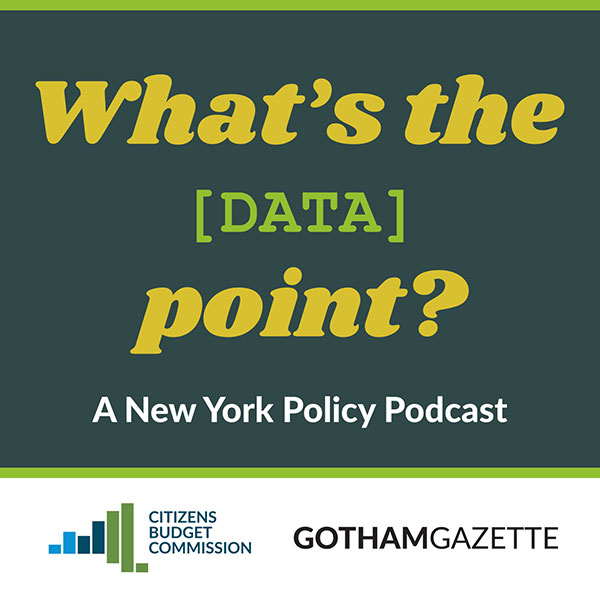
What's The [Data] Point? Episode 31 -- $418 million, with Dana Rubinstein [You can download What's The [Data] Point? wherever you get your podcasts, including on iTunes]

$418 million is the amount that MTA Chair Joe Lhota and Governor Andrew Cuomo want Mayor Bill de Blasio to commit to the Subway Action Plan, the emergency plan to address essential subway repairs and -- in their own words -- stop failing customers. De Blasio has refused.
Dana Rubinstein, who covers the MTA and transit for Politico New York, joined the podcast to discuss the city-state disputes over the MTA, as well as other related topics, including congestion pricing, de Blasio's transit agenda, and more. Rubinstein recently wrote about Lhota's leadership of the authority and about his possible conflicts of interest given his work for Madison Square Garden and discussed those stories as well.
Listen to the conversation and let us know what you think: Ben Max of GG (@TweetBenMax), Maria Doulis of CBC (@MariaDoulis) and guest Dana Rubinstein (@danarubinstein). Listen below or download wherever you get your podcasts!
***
by Ben Max, Gotham Gazette
@tweetBenMax @GothamGazette




